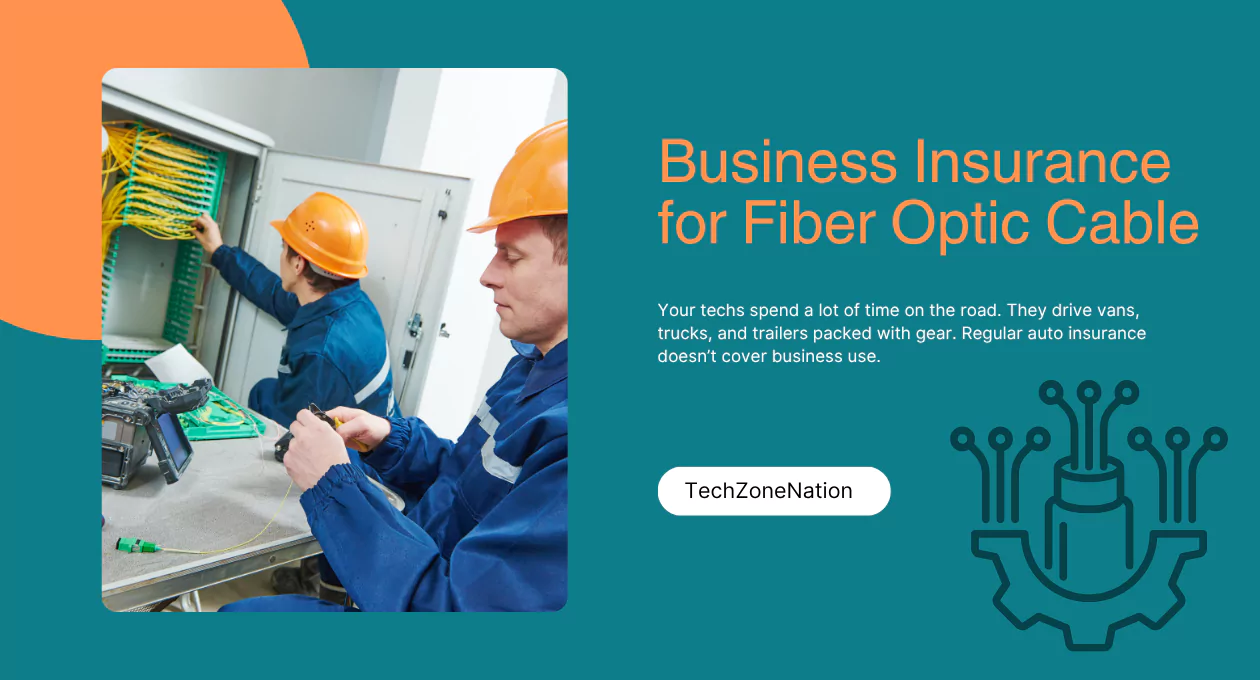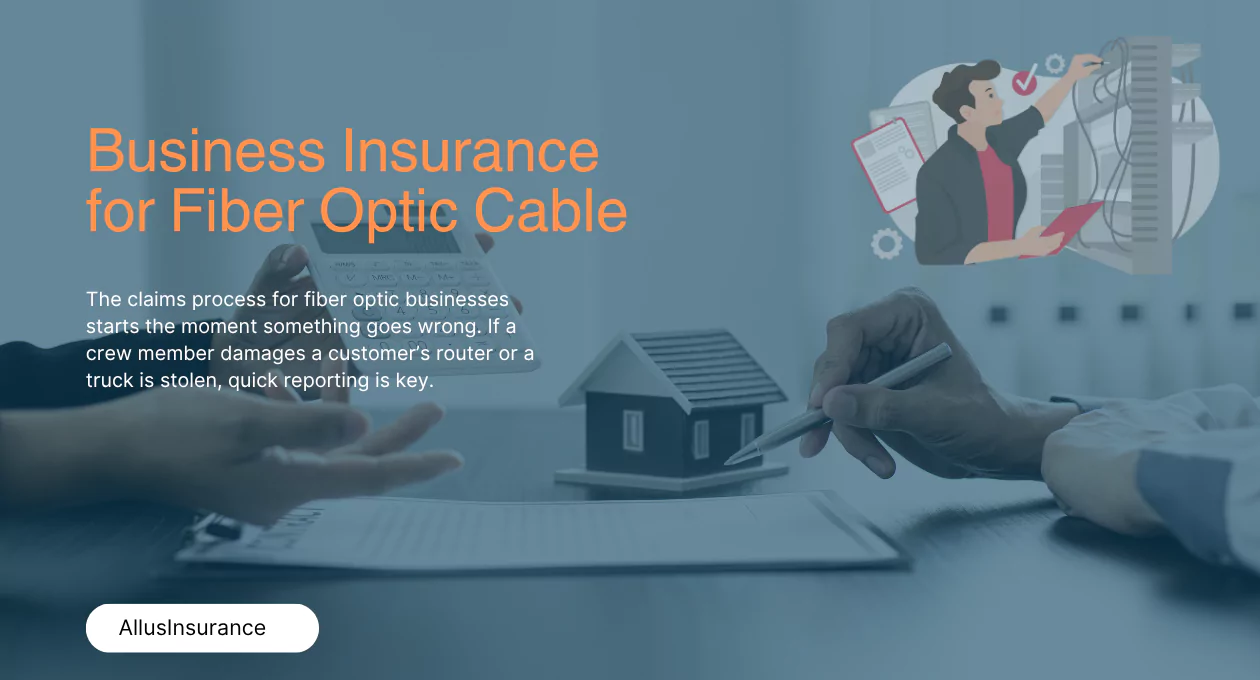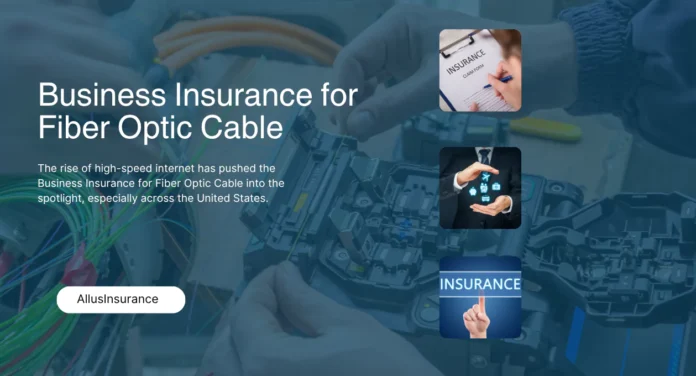The rise of high-speed internet has pushed the Business Insurance for Fiber Optic Cable into the spotlight, especially across the United States. As thousands of miles of fiber optic lines are being laid to meet demand, the risks faced by installation companies continue to grow. Accidents, property damage, worker injuries, and legal disputes are becoming more common—and costly. That’s why having the right business insurance for fiber optic cable is no longer optional, but essential.
This type of insurance provides strong protection for your company, your team, and your tools. It covers everything from job site injuries to damaged equipment, making sure your operations don’t stop after one unexpected event. Specialized policies like general liability insurance, workers’ compensation insurance, and commercial auto insurance offer targeted coverage designed for the unique challenges of telecom projects. If you want lasting success and legal compliance, investing in business insurance for cable technicians is a smart move.
Introduction to Business Insurance for Fiber Optic Cable Industry
The fiber optic installation business in the United States is growing rapidly. More homes, schools, and businesses rely on fiber connections for fast, reliable internet. This expansion creates many opportunities but also new risks for installers, contractors, and business owners.
That’s why business insurance for fiber optic cable has become a must-have. Whether you’re a solo installer or running a large structured cabling business, you need protection from lawsuits, property damage, theft, injuries, and delays. Without insurance, a single accident could shut your company down.
Why Fiber Optic Installers Need Specialized Business Insurance
You can’t rely on general coverage designed for standard trades. Telecom contractor insurance is tailored for the real-world risks you face, like hitting water or gas lines during digging or damaging customer property during installations. These are not small problems. They can turn into six-figure claims fast.
A business owner’s policy (BOP) for fiber installers combines several types of protection in one plan. It typically includes general liability insurance, property coverage, and loss of income due to business interruptions. This policy protects against client lawsuits, job delays, and damaged tools. Without this type of policy, you’re leaving your company wide open to risk.
Understanding Fiber Optic Cables and Installation Risks
Fiber cables are fragile. The glass strands can break with the smallest bend or strain. That means the installation process must be exact. Small mistakes can lead to network outages and major repair costs. Many projects also involve insurance for underground utility work, which comes with risks like cutting into live electrical or gas lines.
There’s also the physical toll on technicians. Climbing ladders, working in crawlspaces, or digging trenches are all dangerous tasks. With more work moving to rural areas and harsh terrains, the risk of injury and property damage increases. That’s where insurance for remote field service teams becomes essential to your business model.
Workers’ Compensation Insurance for Fiber Optic Businesses
Accidents happen, even when you train your team well. A fall from a ladder or a tool-related injury can lead to serious medical costs and lost wages. That’s why workers’ compensation insurance is not just smart — it’s required in almost every U.S. state. It protects both your employees and your company from legal action.
If your fiber optic technician insurance doesn’t include workers’ comp, your business could be fined or shut down. More importantly, this coverage ensures your workers get proper care and support after an accident. With rising healthcare costs in 2025, skipping workers’ comp is a risk you can’t afford.
Commercial Auto Insurance for Fiber Optic Technicians
Your techs spend a lot of time on the road. They drive vans, trucks, and trailers packed with gear. Regular auto insurance doesn’t cover business use. That’s why you need commercial auto insurance. It protects your vehicles, drivers, and cargo from crashes, theft, and vandalism.

In 2025, more telecom businesses are using GPS tracking and telematics to lower their auto insurance costs. If a truck carrying splicing machines gets totaled, your contractor equipment insurance will only help if you have commercial auto insurance to cover the vehicle damage too. These policies work together to protect every part of the job.
Critical Insurance Coverages Needed For Fiber Optic Installers
If you’re unsure what coverage telecom installers need, here’s a table of essential policies for every fiber business in 2025:
| Coverage Type | What It Covers |
| General Liability Insurance | Third-party injuries and property damage |
| Workers’ Compensation Insurance | Medical bills and lost wages for injured employees |
| Commercial Auto Insurance | Company vehicle damage or theft |
| Contractor Equipment Insurance | Tools, gear, and mobile equipment loss or damage |
| Inland Marine Insurance | Transit and offsite equipment coverage |
| Cyber Insurance for Telecom Businesses | Data breaches, hacking, and digital threats |
| Business Owner’s Policy (BOP) | Combines property, liability, and income coverage |
Each of these policies helps answer the question: Do I need insurance to install fiber optic cables? The answer is yes — if you want to stay compliant and financially secure.
Excess Liability and Umbrella Coverage: Why It Matters
Basic coverage limits don’t always stretch far enough. That’s where excess liability coverage comes in. It kicks in when your primary policies max out. For example, if a client sues you for $3 million but your general liability insurance only covers $1 million, umbrella insurance covers the rest.
More fiber companies are being asked to show proof of high-limit policies for government or utility contracts. Without excess liability coverage, you may not even qualify to bid. In 2025, it’s becoming standard for companies working in dense urban areas or near critical infrastructure.
Surety Bond Requirements for Fiber Optic Contractors
If you’re involved in public construction or utility projects, you’ll probably need to secure surety bonds for contractors. These bonds aren’t the same as insurance, but they offer similar protection. They act as a financial promise that you’ll finish the job as agreed. If you fail to do so, the bond provider compensates your client for the loss.
Many states require bonding for cable contractors before granting a license. The most common bond types include bid bonds, performance bonds, and payment bonds. These bonds show that you’re reliable and financially secure, which builds trust with potential clients. In fact, without proper bonding, government agencies and large firms usually won’t even consider your application or proposal.
Comprehensive Coverage Options Tailored for Fiber Optic Businesses
Not every policy fits every business. That’s why top insurance providers now offer tailored options for insurance for cabling businesses. These plans consider the size of your team, the type of work you do, your job locations, and your tools. A large low voltage contractor insurance package looks different from one designed for a solo tech.
For example, inland marine insurance is perfect for businesses that transport splicing machines and testing gear between sites. It covers losses that happen away from your main office. Customizing your coverage ensures you’re protected — without paying for extras you don’t need.
Fiber Optic Cable Installer Insurance Cost in 2025
You’re probably wondering: How much does insurance cost for fiber optic companies? The answer depends on many things, like how many workers you have, how much equipment you own, your past claims, and where you operate. Here’s a breakdown of average monthly costs in 2025:
| Policy Type | Monthly Cost (Avg.) |
| General Liability | $75 – $150 |
| Workers’ Comp | $120 – $300 per employee |
| Commercial Auto | $100 – $250 per vehicle |
| Contractor Equipment | $60 – $180 |
| Cyber Insurance | $80 – $200 |
| Umbrella/Excess Liability | $90 – $300 |
These are just estimates. To find affordable insurance for cable installers, you should compare quotes from multiple telecom-focused providers.
Claims Evaluation and Processing: What Installers Should Know
The claims process for fiber optic businesses starts the moment something goes wrong. If a crew member damages a customer’s router or a truck is stolen, quick reporting is key. You’ll need clear documentation, including photos, job logs, and police reports when applicable.

Most insurers now use digital tools for faster claims. But delays can still happen if paperwork is missing. Some providers even offer 24/7 support for insurance for remote field service teams, helping you stay connected no matter where the problem occurs. Don’t wait. Report issues immediately to avoid denied claims.
Ensuring Compliance with OSHA & Safety Protocols
OSHA safety compliance for installers isn’t optional — it’s the law. This includes wearing proper PPE, following safe climbing practices, and using trench boxes when digging. Insurance companies reward safe businesses with lower premiums and fewer coverage disputes.
To stay compliant, you’ll need to maintain training records, perform regular safety checks, and document incidents. This is also essential if you’re ever audited or investigated after an accident. In many cases, failure to follow OSHA rules can void your insurance policy altogether.
Regulatory Standards and Insurance Compliance in Telecom
The telecom world is heavily regulated. You need to follow FCC rules, national electric codes, and state contractor laws. Without the right licenses, permits, and insurance for fiber optic work, your company could face steep fines or lose access to contracts.
Most government projects now require proof of active utility contractor insurance before work begins. Your policies must list specific coverages, policy numbers, and coverage dates. Keep this paperwork ready, and update it every year to stay in good standing with regulators.
Technological Advances in Fiber Optic Installations and Insurance Needs
New tech means new risks. AI mapping tools, drones for line inspections, and smart sensors all improve efficiency. But they also create new liabilities. If a drone crashes and injures someone or sensitive customer data gets hacked, you could be held responsible.
That’s why cyber insurance for telecom businesses is growing in importance. It covers data loss, ransomware attacks, and digital fraud. And as more equipment uses software updates or remote access, this type of coverage becomes critical for staying protected in 2025.
FAQs
Do I need business insurance for fiber optic cable installation?
Yes, insurance is essential to protect against accidents, lawsuits, and equipment damage. It’s often legally required for telecom contractors.
What does business insurance for fiber optic cable typically cover?
It covers liability, tools, injuries, auto accidents, and job interruptions. Policies can be customized for your specific work and risks.
How much does insurance for fiber optic installers cost in 2025?
Costs vary by business size, location, and coverage. On average, expect $100–$400 monthly for core protection.
Is workers’ compensation insurance required for fiber optic businesses?
Yes, most U.S. states mandate it. It covers employee injuries, medical bills, and lost wages.
Can subcontractors be covered under my insurance?
Only if you add coverage for subcontractors to your policy. Otherwise, they must show proof of their own insurance.
Conclusion: Securing Your Fiber Optic Business for the Future
Running a fiber optic installation business in 2025 means dealing with more risk and regulation than ever before. But with the right business insurance for fiber optic cable professionals, you can stay safe, legal, and profitable. Don’t leave your company exposed to threats that could destroy everything you’ve built.



